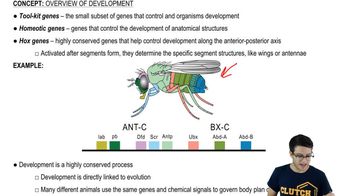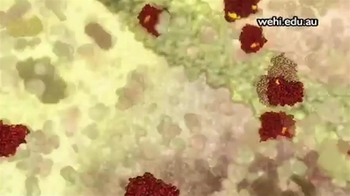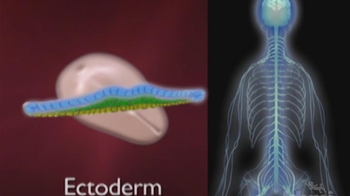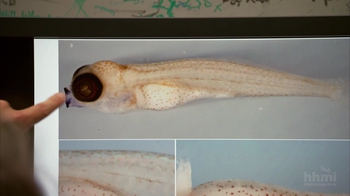Table of contents
- 1. Introduction to Biology2h 42m
- 2. Chemistry3h 40m
- 3. Water1h 26m
- 4. Biomolecules2h 23m
- 5. Cell Components2h 26m
- 6. The Membrane2h 31m
- 7. Energy and Metabolism2h 0m
- 8. Respiration2h 40m
- 9. Photosynthesis2h 49m
- 10. Cell Signaling59m
- 11. Cell Division2h 47m
- 12. Meiosis2h 0m
- 13. Mendelian Genetics4h 44m
- Introduction to Mendel's Experiments7m
- Genotype vs. Phenotype17m
- Punnett Squares13m
- Mendel's Experiments26m
- Mendel's Laws18m
- Monohybrid Crosses19m
- Test Crosses14m
- Dihybrid Crosses20m
- Punnett Square Probability26m
- Incomplete Dominance vs. Codominance20m
- Epistasis7m
- Non-Mendelian Genetics12m
- Pedigrees6m
- Autosomal Inheritance21m
- Sex-Linked Inheritance43m
- X-Inactivation9m
- 14. DNA Synthesis2h 27m
- 15. Gene Expression3h 20m
- 16. Regulation of Expression3h 31m
- Introduction to Regulation of Gene Expression13m
- Prokaryotic Gene Regulation via Operons27m
- The Lac Operon21m
- Glucose's Impact on Lac Operon25m
- The Trp Operon20m
- Review of the Lac Operon & Trp Operon11m
- Introduction to Eukaryotic Gene Regulation9m
- Eukaryotic Chromatin Modifications16m
- Eukaryotic Transcriptional Control22m
- Eukaryotic Post-Transcriptional Regulation28m
- Eukaryotic Post-Translational Regulation13m
- 17. Viruses37m
- 18. Biotechnology2h 58m
- 19. Genomics17m
- 20. Development1h 5m
- 21. Evolution3h 1m
- 22. Evolution of Populations3h 52m
- 23. Speciation1h 37m
- 24. History of Life on Earth2h 6m
- 25. Phylogeny2h 31m
- 26. Prokaryotes4h 59m
- 27. Protists1h 12m
- 28. Plants1h 22m
- 29. Fungi36m
- 30. Overview of Animals34m
- 31. Invertebrates1h 2m
- 32. Vertebrates50m
- 33. Plant Anatomy1h 3m
- 34. Vascular Plant Transport1h 2m
- 35. Soil37m
- 36. Plant Reproduction47m
- 37. Plant Sensation and Response1h 9m
- 38. Animal Form and Function1h 19m
- 39. Digestive System1h 10m
- 40. Circulatory System1h 57m
- 41. Immune System1h 12m
- 42. Osmoregulation and Excretion50m
- 43. Endocrine System1h 4m
- 44. Animal Reproduction1h 2m
- 45. Nervous System1h 55m
- 46. Sensory Systems46m
- 47. Muscle Systems23m
- 48. Ecology3h 11m
- Introduction to Ecology20m
- Biogeography14m
- Earth's Climate Patterns50m
- Introduction to Terrestrial Biomes10m
- Terrestrial Biomes: Near Equator13m
- Terrestrial Biomes: Temperate Regions10m
- Terrestrial Biomes: Northern Regions15m
- Introduction to Aquatic Biomes27m
- Freshwater Aquatic Biomes14m
- Marine Aquatic Biomes13m
- 49. Animal Behavior28m
- 50. Population Ecology3h 41m
- Introduction to Population Ecology28m
- Population Sampling Methods23m
- Life History12m
- Population Demography17m
- Factors Limiting Population Growth14m
- Introduction to Population Growth Models22m
- Linear Population Growth6m
- Exponential Population Growth29m
- Logistic Population Growth32m
- r/K Selection10m
- The Human Population22m
- 51. Community Ecology2h 46m
- Introduction to Community Ecology2m
- Introduction to Community Interactions9m
- Community Interactions: Competition (-/-)38m
- Community Interactions: Exploitation (+/-)23m
- Community Interactions: Mutualism (+/+) & Commensalism (+/0)9m
- Community Structure35m
- Community Dynamics26m
- Geographic Impact on Communities21m
- 52. Ecosystems2h 36m
- 53. Conservation Biology24m
20. Development
Developmental Biology
Problem 8`
Textbook Question
Each blue circle in the figure below represents a cell in a cell lineage. Draw two modified versions of the cell lineage so that each version produces three cells. Use apoptosis in one of the versions, marking any dead cells with an X.

 Verified step by step guidance
Verified step by step guidance1
Start by understanding the concept of a cell lineage, which is a sequence of cells that are derived from a single progenitor cell through cell division.
In the first version, draw a simple cell lineage where the initial cell divides twice, resulting in three living cells. This can be achieved by having the first cell divide into two, and then one of those cells divides again to produce a total of three cells.
For the second version, incorporate apoptosis, which is a programmed cell death process. Begin with the same initial cell division as in the first version.
After the first division, mark one of the resulting cells with an 'X' to indicate that it undergoes apoptosis and dies.
Ensure that the remaining living cell divides again to produce two more cells, resulting in a total of three living cells in this version, despite the occurrence of apoptosis.
 Verified video answer for a similar problem:
Verified video answer for a similar problem:This video solution was recommended by our tutors as helpful for the problem above
Video duration:
1mPlay a video:
Was this helpful?
Key Concepts
Here are the essential concepts you must grasp in order to answer the question correctly.
Cell Lineage
Cell lineage refers to the developmental history of a cell as it progresses from a single progenitor cell to its final differentiated state. Understanding cell lineage is crucial for tracing how cells divide and differentiate, which helps in visualizing the sequence of cell divisions and the fate of each cell in a lineage diagram.
Recommended video:
Guided course

Prokaryote Lineages 1
Apoptosis
Apoptosis is a form of programmed cell death that is essential for maintaining healthy tissue homeostasis and development. It involves a series of biochemical events leading to cell shrinkage, DNA fragmentation, and ultimately cell death, marked by an 'X' in diagrams. Apoptosis is crucial for removing unnecessary or damaged cells during development.
Recommended video:
Guided course

Cellular Interactions and Apoptosis
Cell Division
Cell division is the process by which a parent cell divides into two or more daughter cells. It is fundamental for growth, development, and tissue repair. In the context of cell lineage diagrams, understanding cell division helps in predicting the number of cells produced and their arrangement, which is essential for drawing modified versions of the lineage.
Recommended video:
Guided course

Importance of Cell Division

 5:28m
5:28mWatch next
Master Cell Division and Differentiation with a bite sized video explanation from Jason
Start learningRelated Videos
Related Practice



























![Drosophila Embryogenesis - Anterior/Posterior Patterning [English Captions]](https://img.youtube.com/vi/ZOzKXrOGtgw/mqdefault.jpg)



















